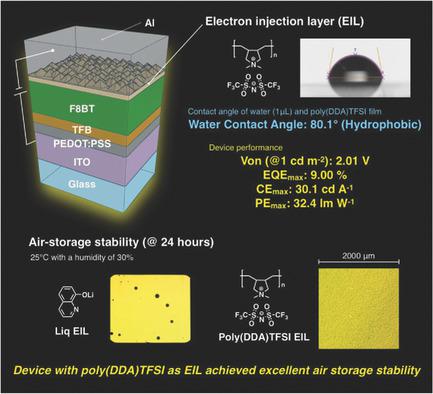当前位置:
X-MOL 学术
›
Adv. Mater.
›
论文详情
Our official English website, www.x-mol.net, welcomes your
feedback! (Note: you will need to create a separate account there.)
Air‐Stable and High‐Performance Solution‐Processed Organic Light‐Emitting Devices Based on Hydrophobic Polymeric Ionic Liquid Carrier‐Injection Layers
Advanced Materials ( IF 27.4 ) Pub Date : 2018-03-13 , DOI: 10.1002/adma.201705915 Shugo Sato 1 , Satoru Ohisa 1, 2, 3 , Yukihiro Hayashi 1 , Ryo Sato 1 , Daisuke Yokoyama 1, 2 , Tetsuya Kato 1 , Michinori Suzuki 1 , Takayuki Chiba 1, 2, 3 , Yong‐Jin Pu 1, 2, 3 , Junji Kido 1, 2, 3
Advanced Materials ( IF 27.4 ) Pub Date : 2018-03-13 , DOI: 10.1002/adma.201705915 Shugo Sato 1 , Satoru Ohisa 1, 2, 3 , Yukihiro Hayashi 1 , Ryo Sato 1 , Daisuke Yokoyama 1, 2 , Tetsuya Kato 1 , Michinori Suzuki 1 , Takayuki Chiba 1, 2, 3 , Yong‐Jin Pu 1, 2, 3 , Junji Kido 1, 2, 3
Affiliation

|
A lot of research, mostly using electron‐injection layers (EILs) composed of alkali‐metal compounds has been reported with a view to increase the efficiency of solution‐processed organic light‐emitting devices (OLEDs). However, these materials have intractable properties, such as a strong affinity for moisture, which cause the degradation of OLEDs. Consequently, optimal EIL materials should exhibit high electron‐injection efficiency as well as be stable in air. In this study, polymer light‐emitting devices (PLEDs) based on the commonly used yellow‐fluorescence‐emitting polymer F8BT, which utilize poly(diallyldimethylammonium)‐based polymeric ionic liquids, are experimentally and analytically investigated. As a result, the optimized PLED employing an EIL comprising poly(diallyldimethylammonium) bis(trifluoromethanesulfonyl)imide (poly(DDA)TFSI), which is expected to display good moisture resistance because of water repellency of fluorocarbon groups, exhibits excellent storage stability in air and electroluminescence performance with a low turn‐on voltage of 2.01 V, maximum external quantum efficiency of 9.00%, current efficiency of 30.1 cd A−1, and power efficiency of 32.4 lm W−1. The devices with poly(DDA)TFSI show one of the highest efficiencies as compared to the reported standard PLEDs. Moreover, poly(DDA)TFSI is applied as a hole‐injection layer (HIL). The optimized PLED using poly(DDA)TFSI as the HIL exhibits performances comparable to those of a device that uses a conventional poly(3,4‐ethylenedioxy‐thiophene):poly(4‐styrenesulfonate) HIL.
中文翻译:

基于疏水聚合物离子液体载体注入层的空气稳定和高性能溶液处理的有机发光器件
为了提高溶液处理的有机发光器件(OLED)的效率,已经进行了许多研究,其中大多数是使用由碱金属化合物组成的电子注入层(EIL)。但是,这些材料具有难处理的特性,例如对水分的强亲和力,这会导致OLED降解。因此,最佳的EIL材料应表现出高的电子注入效率,并在空气中稳定。在这项研究中,通过实验和分析研究了基于常用的发黄光的聚合物F8BT的聚合物发光器件(PLED),该聚合物利用了基于聚(二烯丙基二甲基铵)的聚合物离子液体。结果,采用包含聚(二烯丙基二甲基铵)双(三氟甲磺酰基)酰亚胺(poly(DDA)TFSI)的EIL的优化PLED,-1,功率效率为32.4 lm W -1。与报道的标准PLED相比,具有poly(DDA)TFSI的器件显示出最高的效率之一。此外,将聚(DDA)TFSI用作空穴注入层(HIL)。使用聚(DDA)TFSI作为HIL的优化PLED的性能可与使用常规聚(3,4-乙二氧基-噻吩):聚(4-苯乙烯磺酸盐)HIL的设备相媲美。
更新日期:2018-03-13
中文翻译:

基于疏水聚合物离子液体载体注入层的空气稳定和高性能溶液处理的有机发光器件
为了提高溶液处理的有机发光器件(OLED)的效率,已经进行了许多研究,其中大多数是使用由碱金属化合物组成的电子注入层(EIL)。但是,这些材料具有难处理的特性,例如对水分的强亲和力,这会导致OLED降解。因此,最佳的EIL材料应表现出高的电子注入效率,并在空气中稳定。在这项研究中,通过实验和分析研究了基于常用的发黄光的聚合物F8BT的聚合物发光器件(PLED),该聚合物利用了基于聚(二烯丙基二甲基铵)的聚合物离子液体。结果,采用包含聚(二烯丙基二甲基铵)双(三氟甲磺酰基)酰亚胺(poly(DDA)TFSI)的EIL的优化PLED,-1,功率效率为32.4 lm W -1。与报道的标准PLED相比,具有poly(DDA)TFSI的器件显示出最高的效率之一。此外,将聚(DDA)TFSI用作空穴注入层(HIL)。使用聚(DDA)TFSI作为HIL的优化PLED的性能可与使用常规聚(3,4-乙二氧基-噻吩):聚(4-苯乙烯磺酸盐)HIL的设备相媲美。











































 京公网安备 11010802027423号
京公网安备 11010802027423号